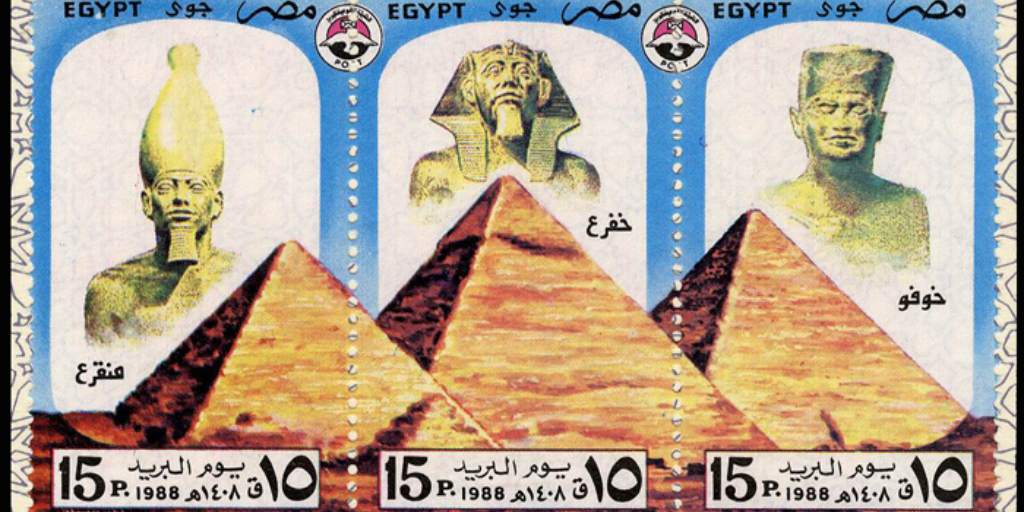In the era of digital communication, social media, emails, and phone calls rule our day-to-day dialogues. In the hustle and bustle of the modern world’s instant communications, the artwork on postage stamps still manages to survive, albeit for different reasons.
Thirty years ago, a postage stamp was a proof of payment, and these stamps were often adorned with artwork pertaining to the sending country: while Egypt may retain the Sphinx and the Pyramids, it is common to see the figure of the Queen on those of the United Kingdom, or the glorious Grey-crowned Crane bird on the stamps of Uganda, for example.
Today, it is a niche collectible, brim with avid collectors who often seek to timeline a country’s history through illustrative stamps of bygone eras.
Egypt’s past postal artworks, distinguished and rich, timelines the country through stamp artworks full of color and character. Bibliotheca Alexandrina’s national archive of stamps is the perfect tool to visualize the country’s timeline.
OTTOMAN EGYPT: THE FIRST-EVER STAMP

Dating back to 1966, Egypt’s first recorded postage stamp was symbolically made of Egyptian cotton, as a green-patterned stamp with the word Misr (Egypt) hand-written in the center. Lacking illustrations and identity, the stamp was a means for the Ottoman Empire to dispatch messages to Egypt.
FIRST ILLUSTRATION, 1967: THE SPHINX AND PYRAMIDS

Ancient Egypt’s history and monuments have mesmerized the world for millennia. It comes as no surprise, then, that the country’s first illustrative stamp would feature the Sphinx and Great Pyramids of Giza at the center.
POST-BRITAIN EGYPT: THE RULE OF KINGS FUAD I & FAROUK

Fouad I of Egypt, an avid stamp collector himself, and the founder of Egypt’s Postal Museum, along with his son, Farouk, ushered in a new era of Egyptian stamps following the country’s independence from Britain in 1922. Under their rule, Egypt’s stamps became far more colorful and illustrative, becoming more portrait-centric.
Fouad would later inaugurate the Egyptian Postal Museum, located in Downtown Cairo, during his reign in 1934, in celebration of the art form.
THE 1952 REVOLUTION: FROM A MONARCHY TO A REPUBLIC

Decades of political and economic unrest during the reign of Farouk culminated in the 1952 Revolution, a transformative period of the country’s history, transitioning from a monarchy to a republic.
The stamp’s artwork is laden with symbolism: it is dated 1952, the same year of the revolution, and showcases a broken chain, symbolizing Egypt’s freedom from British influence. It also places three varying Egyptian citizens in the foreground, and a map of Egypt on a red monolith in the background, all while the sun beams down on it.
While Egypt’s independence from Britain was announced in 1922, many Egyptians came to feel that the country’s true independence came during the 1952 Revolution.
NATIONALIZING THE SUEZ CANAL: SHIPPING OUT COLONIALISM

Egypt’s evolution into a republic was ushered in by the Egyptian army, led by President Gamal Abdel Nasser. Nasser was recognized for his anti-colonial sentiments, made evident by his move to nationalize the Suez Canal in 1956, much to the surprise of Britain, France, and Israel.
Nasser’s nationalization was met with celebration and pride by the Arab world, but the same could not be said of Britain, France, and Israel. Nasser’s move prompted a tripartite attack from the three opposing states, resulting in the Suez Crisis of 1956.
Despite the colonialists’ efforts, Egypt succeeded in strong-holding the canal, becoming an inspiration for other anti-colonial states.
THE UNITED ARAB REPUBLIC: EGYPT’S DREAM FOR UNITY

Following the expulsion of colonials, Nasser further aspired to create a pan-Arab state, by unifying all nations. This ambition was ushered in by the unification of Egypt and Syria in 1958, becoming the United Arab Republic. The stamp, produced the same year as the unification, symbolized that unity through the connecting arch (reads: the United Arab Republic) between the distant borders of each state.
Egypt was known as the United Arab Republic from 1958 until 1971, never fully materializing as Nasser intended it to be.
THE SIX-DAY WAR WITH ISRAEL: EGYPT’S NAKSA (SETBACK)

Decades of industrialization and military development boosted Nasser’s confidence in Egypt’s capabilities. In 1967, Nasser began to mobilize his troops near the Sinai-Palestine border, and then later blocked the Straits of Tiran (showcased on the stamp) as a blockade on Israel’s trade routes.
Nasser’s hostility sparked a pre-emptive strike from Israel, resulting in the Six-Day War, and the defeat of Egypt, Syria, and Jordan. Israel captured Sinai from Egypt, the Golan Heights from Syria, and the West Bank from Jordan.
The stamp, posted weeks prior to the war, serves today as a foreshadowing of what is today known as Al-Naksa (The Setback).
THE 1973 WAR WITH ISRAEL: RECLAIMING SINAI

Six years after the Six-Day War, after the death of Nasser in 1970, now-President Anwar Sadat led Egypt to a retaliative war against Israel in 1973. On 6 October 1973, as dated on the postage stamp, Egypt reclaimed Sinai. It was portrayed as Egypt’s ‘spark of liberation’ and the return of the country’s pride.
PEACE IN SINAI: THE CAMP DAVID ACCORDS

Through the mediation of United States’ President Jimmy Carter and the United Nations, Israel and Egypt agreed to peace in the 1978 Camp David Accords. Through the peace agreement, Egypt’s remaining areas of Sinai, like Taba, were returned to the country by Israel, ushering in an era of diplomatic non-violence.
THE ASSASSINATION OF ANWAR SADAT

The West may have celebrated Sadat’s decision for peace with Israel, but it was met with disdain by most of the Arab world, made evident through Egypt’s expulsion from the Arab League in 1979. On 6 October, 1981, during a commemoration of the 6 October War victory, a group of soldiers fired bullets at Sadat, resulting in his death, a moment that shook Egypt and revived fears of political instability.
THE CONTINUOUS PRESIDENCY OF HOSNI MUBARAK

Sadat’s Vice-President, Hosni Mubarak, was made de facto president following Sadat’s assassination. Mubarak was victorious in all the elections held throughout his 30-year rule, often winning by majority votes, and scrutinized for rigged voting. The stamp in question, the first stamp to feature Mubarak since his ascension to power in 1981, was made to celebrate his third re-election victory.






Comments (4)
[…] […]
[…] […]